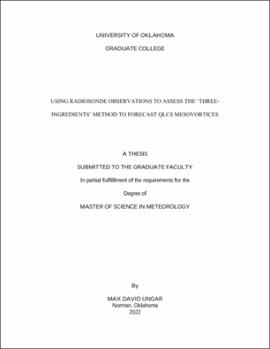| dc.description.abstract | Quasi-linear convective system (QLCS) mesovortices have a propensity to produce impactful severe weather outcomes, including tornadoes and enhanced straight-line wind damage. Despite advances in understanding the origins of these meso-gamma scale vortices over the past two decades, a relative lack of operational tools remain for anticipating their genesis. In particular, genesis of these features can occur over small temporal scales, presenting a challenge in current warning operations.
One tool used widely in the forecasting community is the “Three Ingredients” Method (3-I-M), developed by Schaumann and Przybylinski (2012), which identifies favored QLCS mesovortexgenesis conditions for operational benefit. The 3-I-M assesses both internal system characteristics along with the pre-convective environment to aid in early identification of mesovortex potential. The 3-I-M are 1) a portion of a QLCS in which the system cold pool and ambient low-level shear are said to be nearly “balanced” or “slightly shear dominant”, 2) where 0-3 kilometer line-normal bulk wind shear magnitudes are greater than or equal to 15 ms-1, and 3) where a rear-inflow jet or enhanced outflow causes a surge or bow along the convective line. Despite its widespread use as a tool to predict QLCS mesovortices, this method has not been evaluated extensively in formal literature.
To evaluate the 3-I-M using data not available for the Schaumann and Przybylinski (2012) founding study, environmental data from radiosonde observations in proximity to 50 observed QLCSs, including 9 from past field programs (PECAN, VORTEX-SE, MESO18-19), were compared against QLCS characteristics revealed by nearby WSR-88D observations. Analysis of internal characteristics included assessing the shear/cold pool balance, rear-inflow surges, and observed mesovortices. Analysis shows that nearly half (46%) of mesovortexgenesis events were observed in regimes of sub-critical line-normal 0-3 km wind shear. This agrees with recent studies that found mesovortexgenesis processes can be quite varied and can occur for line-normal shear under the 15 ms-1 threshold. Additionally, the distance between the Updraft Downdraft Convergence Zone (UDCZ) and elevated reflectivity, related to shear/cold pool balance, appears to offer more skill in discriminating mesovortexgenesis potential than line-normal 0-3 km wind shear. This study also offers potential objective criteria for defining favorable shear/cold pool balance “regimes”, along with magnitudes of wind shear across both deeper and shallower depths, favorable for mesovortexgenesis. | en_US |
